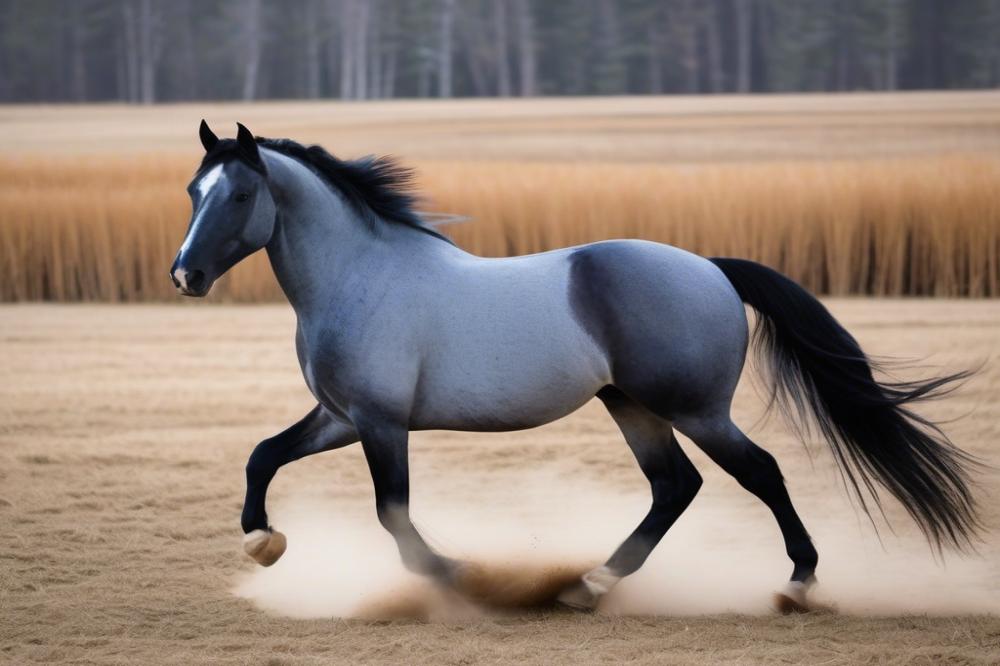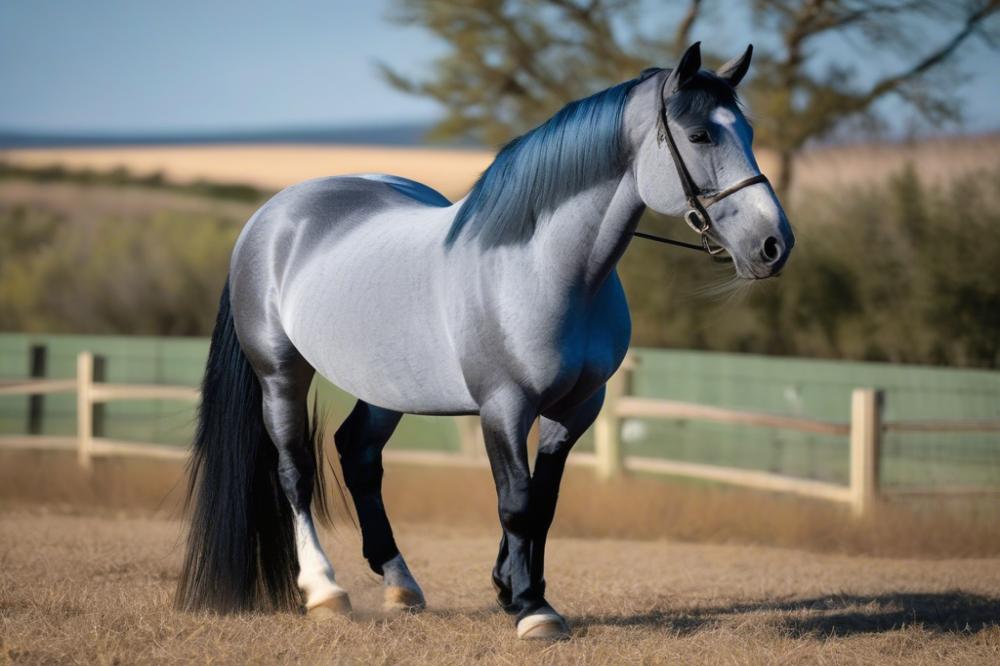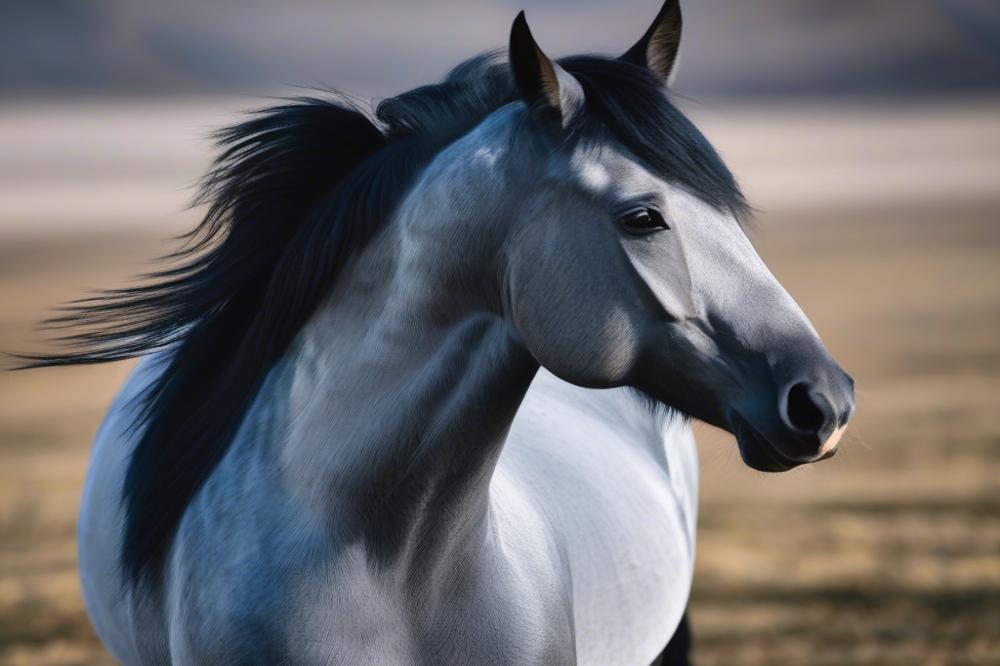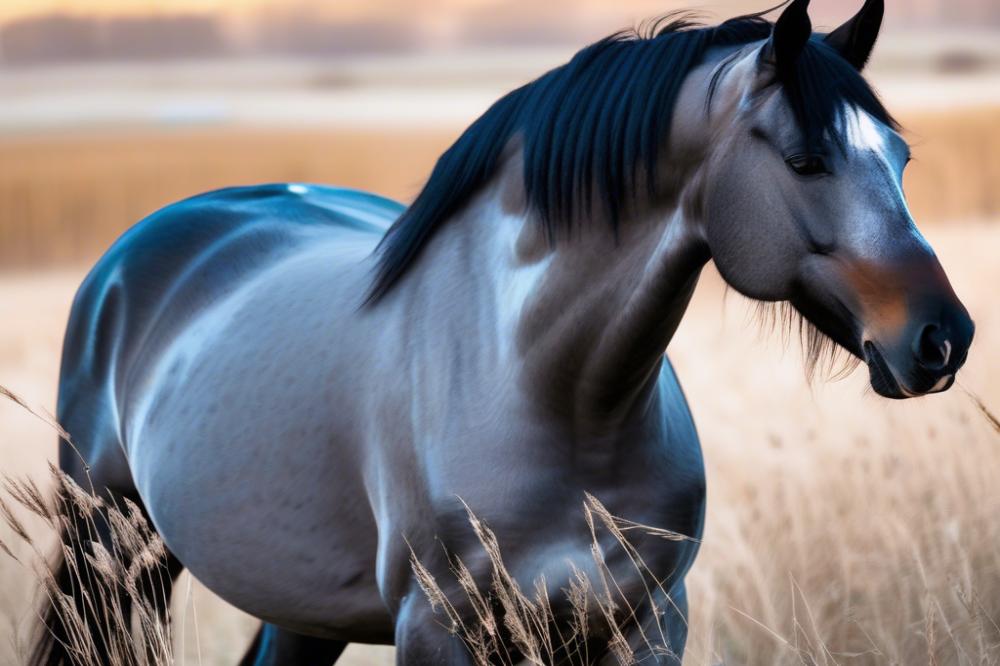What Is a Blue Roan Horse?
When talking about horses, one can’t help but marvel at their beauty and diversity. Among the many colors we see in horses, the blue roan horse stands out with its striking blend of colors. But what exactly is a blue roan horse? In simple terms, this equine has a special coat that mixes black and white hairs, giving it a bluish appearance. This standout feature has made it quite significant in equine culture, often admired in shows and competitions for its eye-catching look.
Coat colors and patterns in horses can be quite fascinating. Think of it like a painter using a palette full of colors. From the vivid chestnut to the mysterious black, horses showcase a stunning array of shades. Understanding these equine colors helps horse lovers identify specific breeds, which often have their own unique characteristics linked to their coats. Take, for example, the buckskin horse, with its golden coat and dark mane—it’s a favorite among many. Just like humans have different hair colors, the variety found in horses can reflect their genetics, history, and even the care they receive.
For anyone who loves horses or is involved in horse care, grasping what makes a blue roan horse special can be very rewarding. Not only does it help with horse identification, but it also enriches one’s appreciation for these animals. For breeders, understanding the nuances of equine genetics can be vital for producing desired traits. Knowledge in this area proves beneficial, as it could help avoid issues like selenium deficiency in horses, which affects their health. In the end, whether you’re a seasoned horse enthusiast or a curious beginner, recognizing the richness in horse coat colors can deepen your connection to these magnificent creatures.
Characteristics of a Blue Roan Horse

Let’s dive into what makes a blue roan horse so special. First off, the blue roan color pattern is a striking mix of black and white hairs. Imagine a starry night sky, but with hair! This coloration isn’t random, though. It results from a combination of genes that affect equine color. The horse must inherit the roan gene from one parent to express this marvelous hue.
Now, is it just blue roan we’re talking about? Not quite! There are other roan colors too, like red and bay roan, but they have very distinct looks. While the blue roan appears grayish or bluish due to the black base overlapping with white, a red roan often features a blend of chestnut and white. That subtle difference in base color can completely change how the horse looks. Therefore, it’s vital to understand these variations when engaging in horse identification.
When you observe a blue roan, you’ll notice more than just its color. Most often, these horses have a strong build, which is typical in many popular horse breeds, from Quarter Horses to Thoroughbreds. Their coats can shine under sunlight or glimmer after a good grooming session, showing off the beauty beneath the surface. This regular horse care is necessary to keep them looking their best.
Not only do blue roans look fantastic, but they also carry the horse breed characteristics you might expect. They often have a confident posture and an animated gait, making them a delight to watch. Their eyes can be quite expressive, and their personality often shines through in their behavior. Like most roans, they can be as varied in temperament as they are in appearance. Some are gentle giants, while others might have a bit of spunk!
In summary, understanding these traits helps in recognizing blue roans in the wild or at a ranch. Their color, combined with their physical features and lively personalities, makes them stand out among many others. Next time you come across one, take a moment to appreciate all the small details that make the blue roan truly captivating.
Genetics Behind Blue Roan Horses

Have you ever wondered what makes a blue roan horse stand out in a crowd? The magic starts at the microscopic level with equine genetics. Let’s break it down.
Roan horses, including blue roans, get their color from a specific combination of genes. The primary factor is a dominant gene known as the ‘roan’ gene. This gene causes a mixture of colored hairs and white hairs in the coat. That’s why roans often look like they’re wearing a sparkly blanket. But blue roans have a twist. They also carry a specific dilution gene, which lightens the black coat to a bluish hue. This unique combination produces the eye-catching color we see.
Inheritance of coat color in horses can get a bit complicated. Each parent contributes genes that decide the traits of the foal. If both parents have the roan gene, the chances of producing a roan foal increase. However, if one parent has a solid color without the roan gene, the foal might not be a roan at all. Horse breed characteristics also play a significant role in this process. Some breeds are more likely to carry the roan and dilution genes than others.
The Role of Dilution Genes
Now, let’s chat about those dilution genes. These little guys are like the fairy godmothers of horse colors. They can lighten dark coats, transforming a black horse into a striking blue roan. It’s fascinating how a simple change in genetics can create such a stunning visual effect. The interplay between these genes can lead to various equine color options, each with its distinct charm.
Understanding horse care is essential for anyone owning these beautiful animals. Knowing the type of coat color and its genetics can help in identifying issues specific to certain colors or patterns. For instance, some colors might be more prone to skin issues in the sun. A little knowledge can go a long way in keeping your horse happy and healthy.
Before you get too lost in the science, remember that genetics is just one piece of the puzzle. Other factors, like the environment and breeding practices, also influence a horse’s final coat color. When looking for your next equine companion, horse identification based on these traits can make all the difference. After all, nothing beats the thrill of finding the perfect horse who also happens to wear that glossy blue roan coat!
Breeds That Can Be Blue Roan

Did you know many horse breeds can show off that striking blue roan color? It’s true! While not every breed is known for this, some are certainly more likely to flaunt it. Blue roan isn’t a breed itself; it’s an equine color that can appear in various types of horses.
The American Quarter Horse is one of the most popular breeds where you might encounter blue roan individuals. Renowned for their versatility and speed, these horses often turn heads not just for their performance but also for their looks. It’s quite the sight to see a Quarter Horse with that silver-blue sheen trotting along!
Next on the list is the Paint Horse. These horses are known for their colorful coats and unique patterns. A blue roan Paint can be a real showstopper in the arena. When these horses shine, they showcase both strength and beauty at the same time. Now that’s a combination anyone can appreciate!
Another breed often found with blue roan coloration is the Appaloosa. These horses are famous for their spotted coats, but they can also appear in roan shades. Appaloosas have a long history, and the blue roan variation adds a different twist to their already colorful palette. Imagine a spotted Appaloosa with that icy blue glow—it gives everyone something to talk about!
Don’t forget about the Thoroughbred! Although you may see more solid colors, blue roans can make an appearance. These horses are primarily known for racing, but when they grace the track, a blue roan Thoroughbred can be quite the spectacle.
Famous blue roan horses often come from these notable breeds. Take “Blue Horse” for example, a celebrated Quarter Horse known far and wide. The power of social media has allowed many blue roans to gain fame as they prance through their daily lives, often shared by their proud owners.
Equine genetics can be a bit of a puzzle. Understanding how the roan gene works can help identify horses with this coloring. A blue roan horse is the result of a specific arrangement of genes that interacts with the black base coat. If you want to dive into horse care or horse identification, knowing how to spot these colors is key.
When talking about the horse breed characteristics, it’s fascinating to see how different breeds can express similar colors in various ways. Each breed carries its own set of traits and qualities. The blue roan coloring adds an extra layer to their charm, making them desirable for many enthusiasts.
Care and Management of Blue Roan Horses
Taking care of a blue roan horse involves some specific considerations. Every coat color has its quirks, and the blue roan is no exception. Regular health checks are key. Just like humans, horses need routine visits from a vet. This helps catch any issues early, and it’s especially important for horse breeds like the blue roan, which can have unique genetic traits.
Grooming is another vital part of horse care. A good grooming routine not only keeps the coat looking shiny but also helps you spot any skin problems. Brushing your horse regularly removes dirt and loose hair. You might even think of it as a way to bond with your equine friend. Consider using a soft brush for the initial groom, followed by a stiffer one for deeper cleaning. Remember, a well-groomed horse always stands out in a crowd.
Maintaining Coat Beauty
To keep that lovely blue roan coat looking its best, you should pay particular attention to diet. A balanced diet rich in vitamins can enhance coat health. Think of it like feeding someone moody a delicious meal—it’ll brighten their day! Adding omega fatty acids can also contribute to a shiny coat. Herbal supplements may help, too, but consult your vet first.
When it comes to identifying color-related problems, check for fading or discoloration. Sun exposure can lead to changes in coat color, and who wants that? Keeping a light sheet over your horse during peak sun hours can help maintain that gorgeous hue. On top of that, bathing should be done in moderation. Overbathing can strip natural oils from the coat, making it look dull.
Unique Grooming Tips
Don’t underestimate the power of a good comb-out and a little elbow grease. Regularly using a rubber curry comb also helps stimulate the skin. This can make your horse feel good, just like scratching an itch. Healthy skin translates directly to a beautiful coat. You’ll also want to check for any irritants, such as bugs or debris, that could affect those shiny blue roan locks.
Horse breed characteristics vary, but the care principles tend to be similar. Knowing how to manage equine color and its demands will ease your burden. Always be on the lookout for any changes in your horse’s health or coat condition. Catching small issues early often prevents larger problems down the road.
In the end, keeping your blue roan horse happy and healthy is a rewarding experience. Think about these care tips like a recipe. You mix a little bit of love, some thoughtful grooming, and a dash of health monitoring. The result? A beautiful horse that turns heads on every trail ride!
Cultural Significance and Uses of Blue Roan Horses
Throughout history, blue roan horses have captured the imagination of people. Their striking color stands out in the equine world, which has led to various perceptions in different cultures. In some regions, these majestic horses symbolize strength and resilience. They have been a part of folklore, reflecting the horse’s connection to the land and people.
Many horse breeds include blue roans, adding to their distinctive appeal. Western riding often features them, where they shine in rodeos and ranch work. Their agility and durability make them favored in various equestrian disciplines including jumping and dressage. Owners select these horses for their evenly distributed coloring, creating a stunning visual on the field.
Speaking of blue roans, their color results from specific equine genetics. This adds a layer of interest for those studying horse breed characteristics. The blending of black and white hairs creates a coat that seems to shimmer in sunlight. Enthusiasts often engage in horse care practices focusing on maintaining this striking coat. Grooming routines become essential for showcasing their unique hue.
When it comes to horse identification, blue roans can sometimes be mistaken for other colors. Education about these shades helps prevent confusion. Their fascinating hue invites questions and conversations, especially among newcomers to the equestrian community. Many times, folks marvel at how the horse’s coat can vary in different lighting.
Blue roan horses often delight spectators during parades and exhibitions. The combination of their beauty and poise creates unforgettable moments. Stories around campfires frequently highlight encounters with these lovely animals, emphasizing how they tend to charm everyone they meet. Their presence in pop culture, from movies to books, further illustrates how they resonate with audiences worldwide.
Wrapping It Up
In summary, blue roan horses are captivating creatures that capture the eye and stir the imagination. Their stunning coats, made up of a mingling of black and white hairs, give them a distinctive appearance that makes them stand out in any herd. As we’ve discussed, the genetics behind this coat color can be a bit complex, rooted in the way that coat color genes interact. While the mix of black and white creates a blue effect, it’s the underlying genetics that really tells the story.
Cultural significance adds another layer to the charm of blue roans. Many horse enthusiasts associate them with strength and beauty, often seeing them as symbols of the wild, untamed spirit of the equine world. They charm not only riders but also spectators, becoming stars in parades and events, where their majestic presence speaks volumes.
Appreciating the diversity within equine coat colors can be incredibly rewarding. Every shade tells a different tale, from the striking dun to the elegant bay. It’s like a painter’s palette, overflowing with colors that represent various traits and histories. If you’re a novice or a seasoned rider, understanding these differences enhances the relationship between you and your horse.
As you delve deeper into the equine world, knowledge truly becomes your best friend. Familiarizing yourself with terms like ‘dressage horse breeds‘ and exploring resources such as a horse human age chart are excellent ways to enrich your understanding. Whether you aspire to ride or simply enjoy horses from afar, staying informed adds to the joy of being a part of this vibrant community.
In the end, let curiosity lead you on this journey. Each horse, with its unique coat color and personality, has something special to teach us. So next time you spot a magnificent blue roan, give a nod of appreciation. After all, every horse has a story, and it’s up to us to listen.



